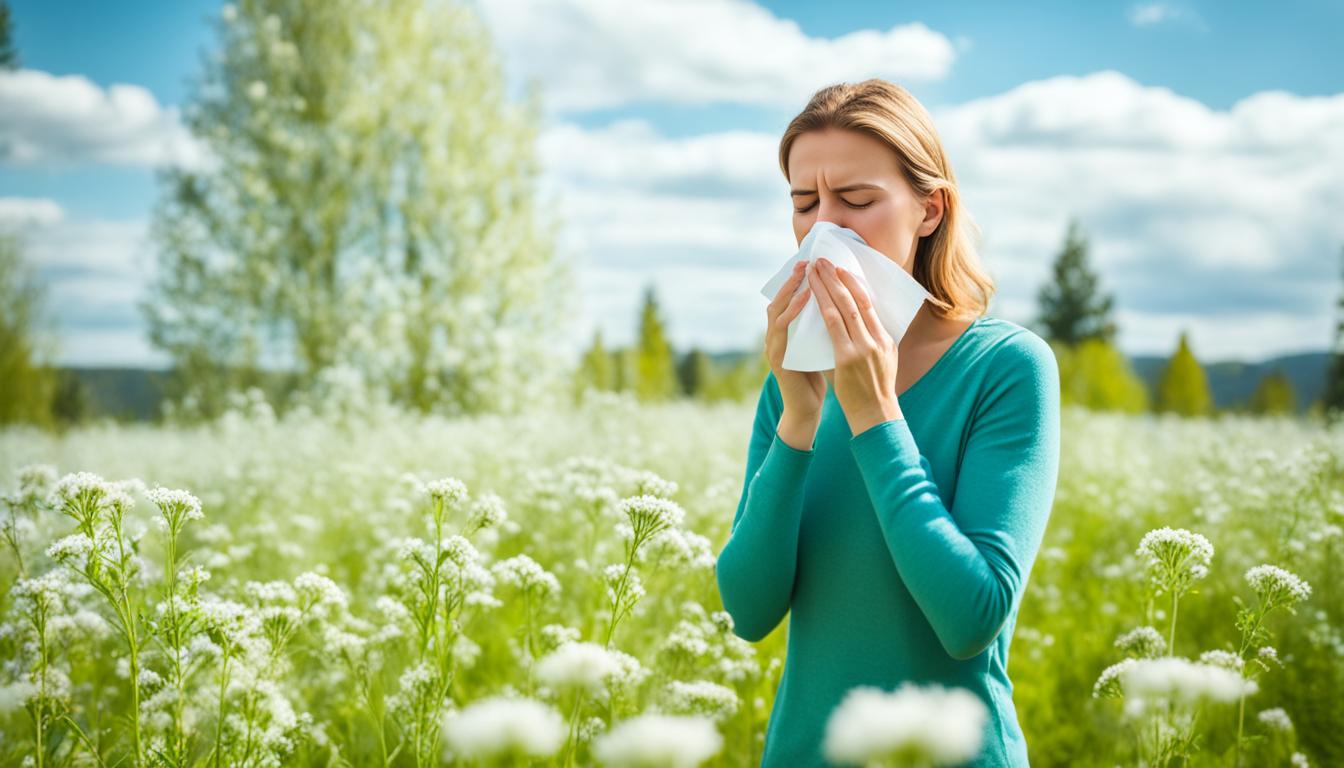In this article, we will explore the connection between weather conditions and seasonal allergies. By understanding the relationship between these two factors, you can better manage your allergies and maintain your overall well-being.
Seasonal allergies, also known as hay fever or allergic rhinitis, are allergic reactions that occur during specific times of the year when certain plants release pollen into the air. The severity of allergy symptoms can vary depending on the weather conditions.
Weather influences play a significant role in the onset and intensity of seasonal allergies. Factors such as pollen, humidity, temperature, and wind can all trigger allergic reactions and worsen symptoms.
In the following sections, we will dive deeper into how different weather conditions impact seasonal allergies and discuss practical strategies for managing allergies in various weather conditions. Whether it’s understanding the effects of pollen, the influence of humidity and temperature, or the role of wind in spreading allergens, this article will equip you with valuable insights to alleviate your allergy symptoms.
How Weather Influences Seasonal Allergies
When it comes to seasonal allergies, various weather conditions can have a significant impact on the severity and frequency of symptoms. Understanding how different weather factors influence allergies can help you better manage your symptoms and find relief.
Pollen: Pollen is one of the most common triggers for seasonal allergies. The amount of pollen in the air is directly influenced by weather conditions. On dry and windy days, for example, pollen particles are more likely to be dispersed in the air, increasing the risk of allergic reactions. Conversely, rainy days can temporarily wash away pollen, providing some relief for allergy sufferers.
Humidity: The level of humidity in the air can also affect seasonal allergies. High humidity can create an ideal environment for mold growth, which can trigger allergy symptoms in susceptible individuals. On the other hand, low humidity can dry out nasal passages, making them more vulnerable to allergens. Maintaining a balanced indoor humidity level and using dehumidifiers can help alleviate symptoms.
Temperature: Temperature fluctuations can impact the release of allergens and intensify allergy symptoms. Higher temperatures can promote the release of pollen and other airborne allergens, increasing exposure and triggering allergic reactions. Cold temperatures, on the other hand, may cause nasal congestion and irritation, exacerbating existing symptoms.
Wind: Wind can play a significant role in spreading allergens over long distances. When the wind blows, it carries pollen, mold spores, and other allergens along with it. This can lead to widespread exposure and more severe allergy symptoms. Being mindful of windy conditions and taking protective measures, such as wearing sunglasses and keeping windows closed, can help reduce exposure to airborne allergens.
By understanding how weather influences seasonal allergies, you can take proactive steps to manage your symptoms. Monitoring pollen forecasts, staying indoors during peak pollen periods, and utilizing appropriate medications and treatments can help you find relief and enjoy the outdoors without discomfort.
The Effects of Pollen on Seasonal Allergies
In this subsection, we will focus specifically on the effects of pollen on seasonal allergies. Pollen is one of the primary triggers for allergic reactions, and its levels fluctuate with different weather patterns. Understanding how pollen affects your allergies is crucial for managing your symptoms effectively.
Pollen is a fine powder released by plants during their reproductive process. When inhaled, it can stimulate an allergic response in individuals with seasonal allergies, also known as hay fever. The immune system identifies pollen as a threat and produces histamines to combat it, causing typical allergy symptoms such as sneezing, itching, and congestion.
The effects of pollen on seasonal allergies can vary depending on the type of pollen, individual sensitivity, and weather conditions. Different types of plants release pollen at different times of the year, resulting in distinct allergy seasons. For example, tree pollen is most prevalent in the spring, grass pollen in the summer, and weed pollen in the fall.
During peak pollen seasons, when pollen counts are high, individuals with seasonal allergies are more likely to experience severe allergic reactions. It is crucial to stay informed about local pollen forecasts and take necessary precautions to minimize exposure to pollen during these times.
Exposure to pollen can have immediate effects on seasonal allergy sufferers, leading to uncomfortable symptoms such as runny nose, watery eyes, and persistent sneezing. Furthermore, prolonged exposure to pollen can exacerbate allergy symptoms and contribute to the development of asthma, a chronic respiratory condition.
To mitigate the effects of pollen on your seasonal allergies, it is advisable to stay indoors during high pollen count days, especially during windy conditions. Keep windows closed, use air purifiers, and regularly clean your living space to reduce the presence of airborne pollen particles. Additionally, wearing sunglasses and a mask when outside can provide some protection against pollen.
Understanding the effects of pollen on seasonal allergies empowers you to take proactive measures to manage your symptoms effectively. By staying informed, minimizing exposure, and seeking appropriate medical advice, you can find relief from the discomfort caused by pollen allergies and enjoy a better quality of life.
Humidity and Seasonal Allergies
Humidity levels play a significant role in the severity of seasonal allergy symptoms. Understanding the relationship between humidity and allergies can help you better manage your symptoms and improve your overall well-being.
High humidity can create an ideal environment for allergens, such as mold spores, to thrive. When humidity levels are elevated, these allergens can become more prevalent in the air, leading to increased allergy symptoms. On the other hand, low humidity levels can cause dryness in your nasal passages and make your respiratory system more susceptible to irritants.
To effectively manage seasonal allergies in different humidity conditions, it’s important to take precautions and make necessary adjustments:
- Monitor humidity levels: Use a hygrometer to measure and keep track of the humidity in your indoor environment. Keeping humidity between 30% to 50% is generally recommended for allergy sufferers.
- Control indoor humidity: Use dehumidifiers or air conditioners to lower humidity levels if they are too high. Conversely, consider using humidifiers to raise humidity levels if they are too low. However, ensure that the humidity remains within the recommended range.
- Keep indoor spaces clean and dry: Regularly clean and dry areas prone to humidity, such as bathrooms and basements, to prevent the growth of mold and reduce allergen exposure.
- Use allergy-friendly bedding: Choose bedding materials that are resistant to mold and dust mites, such as allergen-proof mattress covers and pillowcases.
- Stay hydrated: Drinking an adequate amount of water can help ease nasal dryness caused by low humidity.
By understanding the impact of humidity on seasonal allergies and implementing these strategies, you can better manage your symptoms and reduce the discomfort caused by allergens in different humidity conditions.

The Influence of Temperature on Seasonal Allergies
Temperature fluctuations play a significant role in the impact of seasonal allergies. Changes in temperature can influence the release of allergens and worsen allergy symptoms. Understanding how temperature affects your allergies can help you take proactive steps to manage them effectively.
When temperatures rise, plants and trees release more pollen into the air, triggering allergic reactions. Higher temperatures can also lead to increased humidity, creating favorable conditions for mold growth.
On the other hand, colder temperatures can cause indoor environments to become drier, which may aggravate respiratory symptoms in individuals with allergies. Additionally, cold air itself can be an irritant to the respiratory system, making allergies feel more severe.
To mitigate the influence of temperature on your seasonal allergies, follow these tips:
- Avoid spending extended periods outdoors during peak pollen times when temperatures are high.
- Keep your home well-ventilated and use air conditioning to control indoor temperature and humidity levels.
- During colder months, use a humidifier to add moisture to the air indoors.
- Dress appropriately for the weather to protect yourself from allergens and prevent the onset of allergy symptoms.
- Consult with your healthcare provider for personalized advice on managing your allergies in relation to temperature changes.
By understanding and addressing the influence of temperature on your seasonal allergies, you can optimize your allergy management strategies and minimize discomfort.
The Role of Wind in Seasonal Allergies
When it comes to seasonal allergies, wind plays a significant role in exacerbating symptoms and spreading allergens over long distances. As the wind blows, it carries with it pollen and other allergens, leading to widespread allergy symptoms in affected individuals.
One of the primary allergens transported by the wind is pollen. Pollen grains are lightweight and easily carried by gusts of wind, allowing them to travel far from their source. This means that even if you are not in close proximity to flowering plants or trees, you can still be exposed to pollen if the wind carries it to your area.
Exposure to airborne allergens, such as pollen, can trigger allergic reactions in sensitive individuals, causing symptoms like sneezing, itching, and congestion. The higher the pollen count in the air, the more likely it is for allergy symptoms to occur.
During windy days, it is crucial to take steps to minimize exposure to airborne allergens. Stay indoors with windows closed to reduce the amount of pollen that can enter your home. If you need to go outside, consider wearing a hat and sunglasses to prevent pollen from coming into contact with your face.
Additionally, you can check local pollen forecasts to stay informed about pollen levels in your area. This information can help you plan outdoor activities when pollen counts are lower.
By understanding the role of wind in seasonal allergies and implementing strategies to minimize exposure, you can effectively manage your allergy symptoms and improve your overall well-being.
Managing Seasonal Allergies in Different Weather Conditions
When it comes to managing seasonal allergies, staying prepared for various weather conditions is key. By understanding how weather influences allergies, you can take proactive steps to minimize symptoms and improve your well-being throughout the year.
One effective strategy is to monitor local pollen forecasts. By keeping track of pollen levels in your area, you can anticipate when allergens are likely to be at their peak. This information can help you plan outdoor activities accordingly and take necessary precautions to reduce your exposure to allergens.
In addition, maintaining an allergen-free indoor environment can make a significant difference in managing seasonal allergies. Regularly cleaning and vacuuming your home, especially in high-allergen areas like carpets and upholstery, can minimize the presence of allergens. Using air purifiers and keeping windows closed during high-pollen days can also help create a more allergy-friendly living space.
Finally, when symptoms persist, utilizing medications effectively can provide much-needed relief. Over-the-counter antihistamines, nasal sprays, and eye drops can help alleviate allergy symptoms. However, it’s essential to consult with your healthcare provider before starting any new medications to ensure they are suitable for your specific allergies and overall health.






